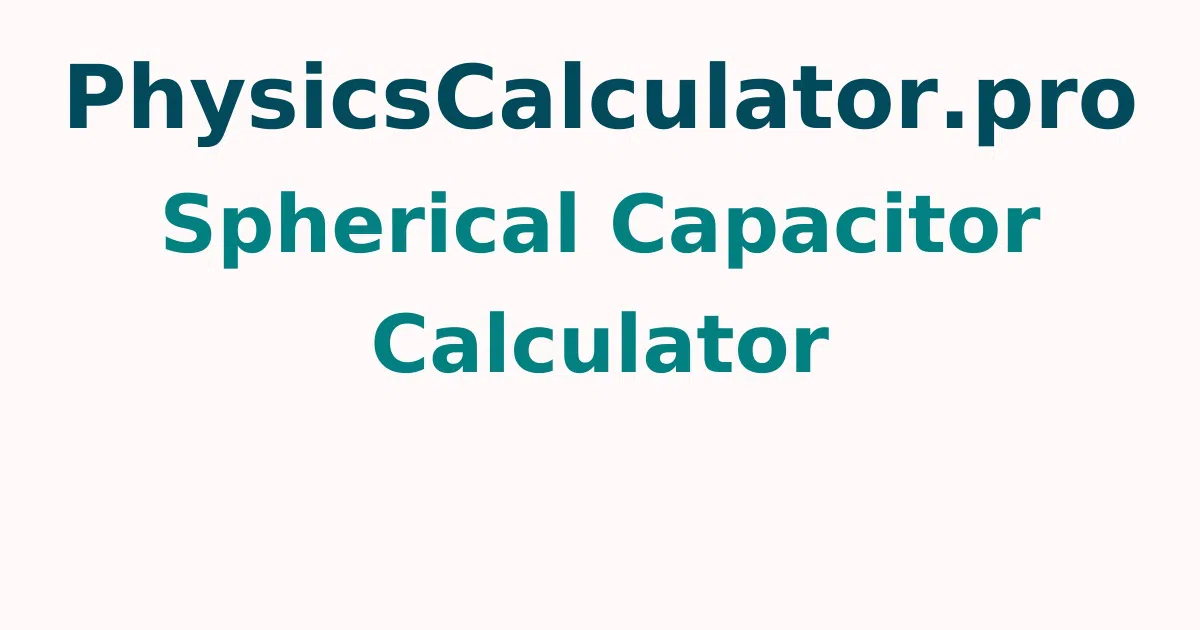Spherical Capacitor Calculator
To get the output in a fraction of a second, simply enter the inner and outer radius of the spherical capacitance in the input boxes of the spherical capacitor calculator and press the calculate button.
What is a Capacitor?
A capacitor is a component of an electrical circuit that can both store and discharge electric charges. Many electronic devices use capacitors to accomplish several activities, such as smoothing, filtering, or bypassing an electrical signal. The capacitor is a simple device that is made up of two plates that are separated by a gap.
A number called capacitance is used to calculate the amount of electric charge that can be held by a capacitor. The larger the capacitance, the more electric charge the capacitor can keep. Filling the area between the plates with a nonconducting dielectric material will enhance capacitance even more.
Spherical Capacitor Equation
A capacitor is a type of electrical device that can store and discharge electricity. Filtering, smoothing, and bypassing of electrical signals are all done with these in many electronic devices. The capacitance of a capacitor is the amount of electric charge stored in it.
In a circuit, spherical capacitors can be wired in series or parallel. If the capacitor is made up of three concentric spheres with varied dielectrics in the space between them. When those capacitors are connected in series, the equivalent capacitance reciprocal equals the sum of each capacitor's reciprocal capacitance.
The overall capacitance in the circuit equals the sum of the all-spherical capacitors capacitance when the capacitors are linked in series.The following is the spherical capacitor with the dielectric equation
C = 4πε0εk/(1/a - 1/b)
- Where, C = spherical capacitor capacitance
- a = inner radius of the spherical capacitor
- b = outer radius of the spherical capacitor
- ε0 = vacuum permittivity constant and its value is 8.85 × 10-12 F/m
- εk = relative permittivity and its value is 1
Spherical Capacitors in Parallel or Series
Spherical capacitors can be used in both parallel and series configurations.Consider a capacitor made up of three concentric spheres with different dielectrics filling the spaces between them. We can regard those spaces as if they were individual capacitors connected in series, and the total capacitance can be calculated similarly to parallel resistors.
Imagine that our capacitor is made up of two concentric spheres with the space between them divided into two halves, each filled with a different dielectric material. Both halves can be treated as distinct capacitors connected in series, and the overall capacitance can be computed similarly to resistors in series.
How do you calculate Spherical Capacitance?
The following sections will show you how to simply calculate the capacitance of a spherical capacitor.
- Step :1 Make a note of the inner and outer radius of the capacitor.
- Step 2: Calculate the relative permittivity, vacuum permittivity constants, and 4π as a product.
- Step 3: Subtract the reciprocal of the sphere's outer radius from the reciprocal of the sphere's inner radius.
- Step 4: To find the capacitance, divide the product by the subtracted value.
For more concepts check out physicscalculatorpro.com to get quick answers by using this free tool.
How to use the Spherical Capacitor Calculator?
The following is the procedure how to use the spherical capacitor calculator
- Step 1: Enter the unknown value of inner and outer radius of the spherical capacitance and x in the appropriate input fields.
- Step 2: To acquire the result, click the "Calculate the Unknown" button.
- Step 3: Finally, the output field will show the capacitance of a spherical capacitor.
FAQs on Spherical Capacitor
1. What is a spherical capacitor, exactly?
The spherical capacitor is made up of a concentric hollow spherical conductor surrounded by a hollow or solid spherical conductor.
2. Is it possible to get a spherical capacitor?
Two concentric spherical conducting plates make up a spherical capacitor. Assume that this is the outer spherical surface, or sphere conducting plate and that this is the inner spherical surface.
3. What is an isolated spherical capacitor?
An isolated sphere is made up of concentric spheres with the outer sphere at an infinite distance from the centre and zero potential.
4. How can you find out how many capacitors are in a series?
Capacitors are said to be in series when they are connected one after the other. The total capacitance of capacitors in series can be calculated by summing the reciprocals of the individual capacitances and taking the reciprocal of the sum.
5. Does the quantity of charge on a spherical capacitor affect its performance?
It's important to remember that the capacitance is solely determined by geometrical considerations, not by the quantity of charge or the voltage across the capacitor.
